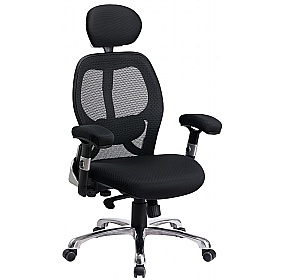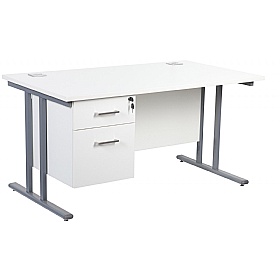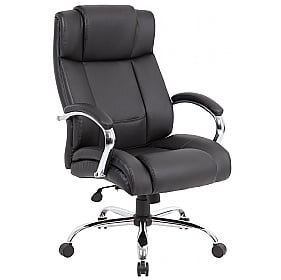-
- 0203 991 1375
- Sign In
Opening Hours:
Mon - Fri 9am - 5.30pm

The Benefits of Working from an Office: How Office Furniture Enhances Productivity
In the wake of the COVID-19 pandemic, remote work has become a prominent feature of the modern professional landscape. Many employees have adapted to working from the comfort of their homes, leading to discussions about the future of traditional office spaces. However, as the dust settles and companies evaluate their remote work policies, it is essential to consider the enduring benefits of working from an office. Among the factors that influence an employee's performance and overall job satisfaction, office furniture plays a significant role. In this article, we will explore the advantages of working from an office and delve into how office furniture can affect productivity.
The Office Advantage.
1. Separation of Work and Home Life
One of the primary advantages of working from an office is the clear separation it offers between work and personal life. Remote work often blurs these boundaries, making it challenging for individuals to "clock out" mentally and physically. In contrast, an office provides a dedicated space where work-related activities are concentrated, leaving home life undisturbed. This separation contributes to a healthier work-life balance, reducing stress and enhancing overall well-being.


2. Professional Atmosphere
The office environment exudes professionalism and fosters a sense of community. It brings employees together under a shared vision and culture, promoting teamwork and collaboration. In-person interactions facilitate the exchange of ideas, creative problem-solving, and the cultivation of a supportive work community. These interactions can be challenging to replicate remotely, where virtual meetings and digital communication tools can only partially substitute for face-to-face connections.
3. Access to Resources
Offices are equipped with resources that are often unavailable or underutilised in remote work settings. High-speed internet, specialised equipment, and office supplies are readily accessible, boosting productivity. Moreover, offices typically have meeting rooms and presentation spaces, allowing teams to convene and brainstorm in an environment designed for collaboration.


4. Mentoring and Learning Opportunities
In an office, employees have direct access to mentors, supervisors, and colleagues who can offer guidance and facilitate learning. The informal conversations and mentorship that occur naturally in the office are invaluable for career growth. Junior employees can benefit from the expertise of more experienced colleagues, fostering professional development that may be stunted in remote work situations.
5. Networking
Networking is a vital aspect of career advancement, and offices provide a platform for employees to build valuable professional connections. Serendipitous encounters, shared lunches, and after-work social events can lead to new opportunities and career growth. Networking becomes more challenging in remote work arrangements, as it relies on scheduled video calls and virtual events.

The Impact of Office Furniture on Productivity
Having established the benefits of working from an office, it's essential to explore how office furniture plays a pivotal role in enhancing productivity:
1. Ergonomic Design for Comfort
Office furniture is specifically designed for comfort and productivity. Ergonomic office chairs and desks provide essential support for employees who spend extended hours at their workstations. Proper lumbar support, adjustable height, and well-padded chairs help reduce the risk of discomfort and musculoskeletal issues that can arise from poor posture. Comfortable employees are more focused and less distracted by physical discomfort.Office furniture is specifically designed for comfort and productivity. Ergonomic chairs and desks provide essential support for employees who spend extended hours at their workstations. Proper lumbar support, adjustable height, and well-padded chairs help reduce the risk of discomfort and musculoskeletal issues that can arise from poor posture. Comfortable employees are more focused and less distracted by physical discomfort.
2. Organisation and Efficiency
Efficiency is a key factor in office productivity. Well-designed office furniture, such as filing cabinets, shelving units, and desktop organisers, help employees keep their workspace organised and clutter-free. This, in turn, reduces the time wasted searching for documents or supplies and promotes a streamlined workflow.
3. Collaborative Workspaces
Many modern offices incorporate collaborative spaces and flexible furniture arrangements to encourage teamwork and creativity. These spaces often feature modular furniture that can be easily reconfigured to suit different types of meetings or group work. The presence of such furniture fosters spontaneous collaborations and brainstorming sessions among employees, leading to innovative solutions and increased productivity.
4. Focus and Concentration
In open-plan offices, office furniture is strategically arranged to provide individual workstations where employees can focus and concentrate on tasks without distractions. Cubicles or partitioned workspaces create a sense of privacy while still promoting interaction when needed. The right furniture layout can strike a balance between collaboration and individual work, boosting overall productivity.
5. Aesthetic Appeal
The aesthetics of office furniture should not be underestimated. Well-designed, aesthetically pleasing office furniture can enhance the overall ambiance of the office. A visually appealing workspace can have a positive impact on employee morale, motivation, and creativity. Employees are more likely to feel inspired and engaged in an environment that is thoughtfully designed and aesthetically pleasing.
6. Health and Well-being
Office furniture also plays a role in promoting employee health and well-being. Adjustable standing office desks allow employees to switch between sitting and standing, reducing the risks associated with prolonged sitting. Furthermore, some office furniture incorporates ergonomic features that encourage physical activity and movement, such as balance ball chairs or sit-stand stools. A healthier workforce is generally more productive and has fewer sick days.
Conclusion - Working in the office with the correct Office Furniture enhances productivity
While remote work has undoubtedly proven its value, the benefits of working from an office cannot be overlooked. Offices offer a structured environment that promotes work-life balance, professionalism, and resource accessibility. Moreover, the role of office furniture in enhancing productivity is undeniable. Ergonomic design, organization, collaborative workspaces, focus, aesthetics, and health considerations all contribute to a more productive and satisfying work experience.
As businesses navigate the future of work arrangements, they should carefully consider the advantages of maintaining physical office spaces and investing in high-quality office furniture. Striking the right balance between remote and in-office work, along with thoughtful furniture choices, can lead to a workforce that is not only productive but also motivated and satisfied in their roles.

The Boffins
- About Us
- Contact Us
- How to Order
- Help/FAQ
Terms & Conditions
- Cookie Policy
- Privacy Policy
- Returns Policy
- Terms & Conditions
- Modern Slavery Policy








